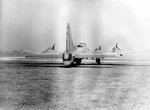johnbr
2nd Lieutenant
During World War II, one of the constant tensions for combat air force leaders was quantity versus quality, usually played out in answering the question of "what modifications produced enough added value they were worth slowing the production line for?"
The usual answer was "very few," so may air forces took a short cut and produced field modifications to improve the combat performance of front line aircraft. The most numerous and formal were the German Luftwaffe's "Rüstsätz," or field modification kits, to increase or vary the armament of its fighters.
The U.S. had a less formal system of modifications at forward field depots, notably "Pappy" Gunn's armament modifications on A-20s and B-25s in the South Pacific, but the Army Air Force considered the most important field modifications were those on the 8th Air Force Bomber Command's B-17 "Flying Fortresses" flying out of England.
Though the B-17 was one of the war's outstanding bombers, when it began flying combat missions over Europe in late 1942, its first encounters with Luftwaffe fighters made it seem anything but a "flying fortress."
The most common complaint was the limited, hand-held forward firing armament, which the German fighters exploited with head-on attacks. Other complaints were with tail heaviness, which made it tiring to fly in tight formation, poorly organized crew positions and a flawed oxygen supply system.
One of the 8th Air Force's engineering officers, Maj. Robert J. Reed, was given the task of solving the problems, and in a few months he came up with a long list of suggested improvements for the B-17. The changes were beyond the capability of the U.S. depots in England to make, so the 8th Bomber Command gave Major Reed a B-17E and sent him back to Wright Field, Ohio, to make the modifications.
Major Reed's changes were radical, especially in armament. He took the nose and tail power-operated turrets from a B-24 Liberator and mounted them on the B-17, where they provided much more firepower and better armor protection. The tail turret had a field of fire about six times greater than the original B-17 turret.
Since the nose was now taken up by the turret, the bombardier was moved to an under nose gondola, which provided such excellent visibility that he acted as the navigator too, reducing the number of crew members from 10 to nine.
The radio operator and his equipment were moved from the middle of the aircraft forward to a compartment next to the bombardier gondola, making it possible for them to communicate if the inter phone was shot out. More importantly, this moved the center of gravity forward and eliminated the tail heaviness. As an added benefit, this required a longer antenna wire, which provided a stronger signal.
The dorsal and ball turrets were replaced with lighter, roomier and better armored models, and the two waist gun positions were removed and replaced by a power boosted twin .50 machine gun mounted on top of the fuselage just above the old waist gun positions. It required only a single gunner, so the number of crew members was further reduced to eight.
The "barn door" type bomb bay doors were replaced with folding doors that extended only 8 inches into the slip stream. This cut drag during the bomb run and provided a tactical advantage, since the folding bomb bay doors were invisible from a distance. This meant that open bomb bay doors would not alert German fighters when the bomb run was beginning and the bombers could not maneuver. The oxygen system was redesigned so each crew member had double lines so if one was cut he would still receive a half supply.
The final results for the "Dreamboat," as the project was nicknamed, were weight reduction of more than 1,000 pounds, the center of gravity moved forward to a nearly ideal point, all the manually operated machine guns were replaced with power operated weapons, and two crew members were eliminated. Speed and altitude performance remained the same because the drag of the bombardier's "gondola" offset the reduced weight and improved the center of gravity.
When Major Reed brought the "Dreamboat" back to England in September 1943, it was well received. The formation flying characteristics were vastly improved, and the folding bomb bay doors and new oxygen system, seemingly minor points, were praised by the crews flying daily combat over Germany. The main complaint was the concentration of all the key crew members in the nose where they could be taken out with a single cannon shell.
Despite the improvements, incorporating the changes into the B-17 production line would have resulted in unacceptable delays for retooling and they were too extensive to be done in England, so Major Reed's "Dreamboat" remained an object of curiosity in various depots for the rest of the war. The project was not, however, for naught. Many of Major Reed's changes were incorporated in the new Boeing B-29 Superfortress and Convair B-32 Dominator, which were in their initial test stages and were to replace the B-17.
(
Attachments
Last edited:

